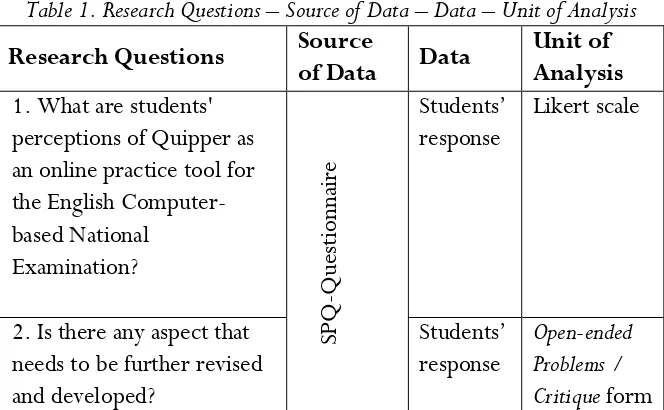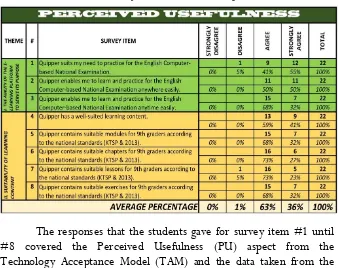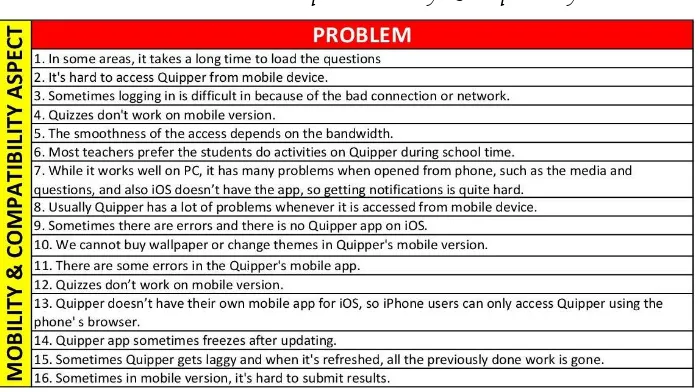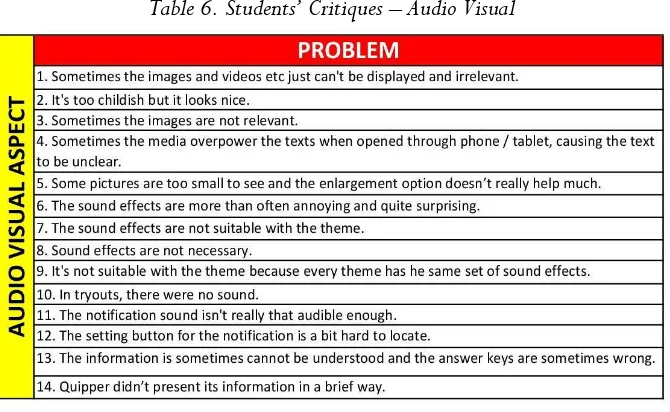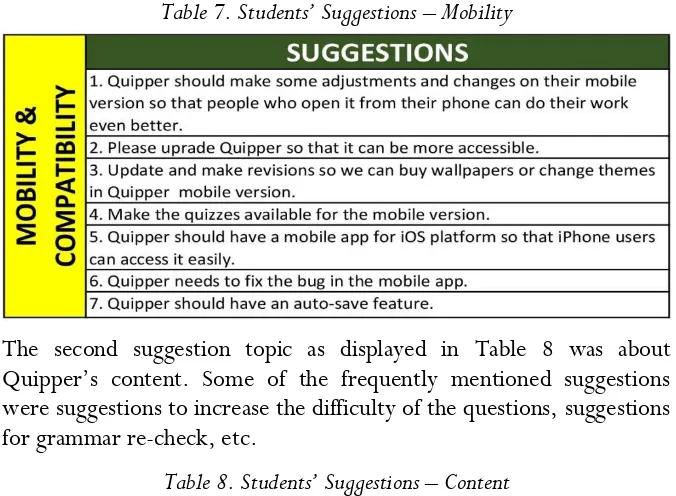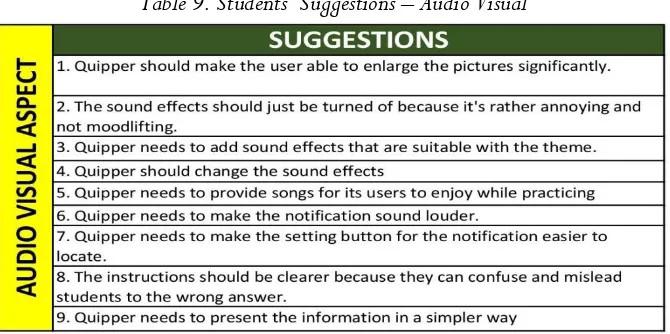248 IJET | Volume 6, Issue 2. December 2017
STUDENTS’ PERCEPTION OF QUIPPER AS AN
ONLINE PRACTICE TOOL FOR THE ENGLISH
COMPUTER-BASED NATIONAL EXAMINATION
Satria Andy Kirana
Email: [email protected]
VITA Junior High School Surabaya, Indonesia
Abstract. This study is a descriptive case study that tries to follow the students‟ learning process in using Quipper, an e-learning platform to prepare them for the upcoming Computer-based National Examination. During the length of the research, the students‟ perception of Quipper as a practice tool will be gathered and presented, along with the aspects that need to be further developed in the future, and students‟ suggestions on how to develop Quipper into an e-learning platform with better functionality. Results of the study revealed that the students have positive perception towards Quipper with several notes about the need to revisit the functionalities and user interface according to what most students would be comfortable with as users. Further, the study also revealed critiques from the students for Quipper‟s future developments. Finally, on the basis of the critiques, some suggestions were also given by the students participated in this study. The suggestions consisted of conducting more research on another level of educations besides junior high school to get the overall idea of what the users from all age range need and also the need to conduct research on several other e-learning platforms.
Keywords: perception, quipper, computer-based national examination, technology acceptance model
INTRODUCTION
For the very first time in 2015, students at 556 schools (about 2% of all high schools in Indonesia) took an electronic version of the exam with the hope that it would cut down on costs to print and distribute the test. There were several drawbacks since many schools
in Indonesia still haven‟t made investments in computers, yet there
IJET | Volume 6, Issue 2. December 2017 249 way to take advantage of those facilities since it was also helpful to
enhance students‟ computer literacy skills which are already considered as a basic need.
The computer-based exam system requires students to log in, download questions, which come together with multiple-choice answers, and then answer the questions by simply clicking on the right answer. Some students said that the computer-based tests have helped them fully concentrate on the questions, as they no longer need to worry about shading circles correctly, as students are required to do on the paper exams. All they have to do is enter their ID, password
and then just click on the right answer. That also means that they don‟t
need to worry about making mistakes when answering questions, such as shading over the line on conventional paper exams(Wirdana, 2015).
An idea then came up to use Quipper to help 9th grade students prepare for the upcoming Computer-based National Examination. Quipper is an online learning platform which provides lessons and tests for ages 8-18, created with the help of an experienced team of educators. Teachers can receive instant feedback on their students‟ performance; identify strengths and weaknesses in a matter of clicks, and save a lot of paperwork.
This study was conducted to find out the ninth grade Junior High School students' perception of Quipper as an online practice tool for the English Computer-based National Examination, to find out whether the ninth grade Junior High School students encounter any flaws or problems during their practice sessions for the English Computer-based National Examination using Quipper and also to find ways to improve Quipper as an exam practice tool using feedback given by the students.
Although the study has some limitations due to the small number of participants and possible chances for the students to be
biased towards the teacher‟s preference, the study aims to help uncovering critical areas within the application of Quipper as an online practice tool for the Computer-based National Examination that needs
to be improved based on the students‟ experience in the classroom and
250 IJET | Volume 6, Issue 2. December 2017 LITERATURE REVIEW
This part presents the related theories concerning e-learning, standardized testing and Technology Acceptance Model, and also some previous studies conducted by other researchers.
E-learning
E-learning can be approached from 2 basic angles – it can be seen either as an “educational process” or as a “set of tools supporting
the educational process” (Kopecky, 2006). Consequently, there is a wide range of definitions that may differ according to the organization and the way of e-learning usage.
For the purpose of this study the term e-learning can be illustrated by comparing and combining the following definitions: "E-learning is understood as a multimedia support of educational process using modern information and communication technologies usually implemented through computer networks. Its main task is free and in time and space unlimited access to knowledge" (Kopecky, 2006).
Synchronous online e-learning requires a constant connection to the net while students communicate with their teachers in real time, which means they can chat, virtually telephone or video conference. Asynchronous online e-learning is presented by communication among participants who are not connected to a net at the same time. They communicate through sent messages in discussion forums or they send e-mails. Offline e-learning does not require a participant's computer to be connected to any net. Study materials are provided thanks to memory tracks, such as CD-ROMs, DVD-ROMs or disks. This is hugely used at basic and secondary schools where present education is joined with an e-learning multi-media support to create so-called blended learning (Kopecky, 2006).
The advantages of e-learning can be summarized as follows (Zlamalova, 2006):
1. higher efficiency of education (flexibility, well-arranged structure with small units, multi-media elements);
IJET | Volume 6, Issue 2. December 2017 251 4. low costs of education (for a society as a whole, for educational
institution and also for a student);
5. easy up-dating of an educational content and used methods;
6. more possibilities for knowledge testing of a student;
7. high rate of interactivity;
8. easy administration;
9. increase in ICT skills of students and also teachers.
While the disadvantages of e-learning can be summarized as follows (Zlamalova, 2006):
1. dependence on technology;
2. incompatibility of components;
3. unsuitability for certain types of courses; 4. unsuitability for certain types of students;
5. bad solution of interactivity (too much or absence);
6. high initial costs for an educator (to prepare and start the study).
Standardized Testing in Indonesia
Standardized testing has long been the dominant feature in the education system in the Republic of Indonesia. Standardized testing has long been the dominant feature in the education system in the Republic of Indonesia. It was explained by Furqon (2004) that in the period of 1965-1971 the Ujian Negara (State Exam) was done for almost all subjects for students at the end of each of the school level, elementary, middle school, and high school. Although, a non-standardized testing policy was endorsed for the next 7 years, where schools were given the authority to design and hold the final exam based on the guidelines from the central government, in 1980 Indonesia went back to the
centralized exam system. The EvaluasiBelajarTahapAkhirNasional
(National Final Learning Evaluation), commonly shortened as Ebtanas, was implemented for 21 years.
As from the early 2015, the National Examination changed its
function from being the only aspect that can determine a student‟s
graduation into only a tool to measure students‟ competence and map
schools‟ performances. There is no longer a minimum passing grade,
252 IJET | Volume 6, Issue 2. December 2017
For a student to be judged competent, for example, he or she should earn a score of at least 5.5 on a scale of 1-10 for each subject.
Those who score below the standard are allowed to take the exam again. Graduating high school students can use the results of their National Examination to apply for university. Junior high graduates can use them to enroll in a state high school of their choice.
Quipper in Indonesia
The teaching and learning process at secondary education level, both junior and senior high schools in Indonesia, has made a significant progress with the emergence of e-learning platforms, one of which is Quipper. Founded by Masayuki Watanabe in London in December 2010, Quipper is an e-learning platform that provides 2 main services
1. Quipper School Learn (learn.quipper.com) is a special portal
where students can access and read course materials, answer questions, send a message to the teachers, and learn to see the performance of her classmates.
2. Quipper School Link (link.quipper.com) is special portal for
teachers where they can set up tasks, see the development of the students, send a message to students, manage the classroom, and make online classes. provider of learning materials for at least 10 subjects commonly taught in public and private schools in Indonesia, with more than 1,300 free-to-choose topics.
Technology Acceptance Model
IJET | Volume 6, Issue 2. December 2017 253 use, based on perceived usefulness, perceived ease of use, and attitude (Davis, 1989).
Davis (1989) and Davis, Bagozzi, &Warshaw (1989) developed the TAM by adapting the Theory of Reasoned Action (TRA) (Fishbein & Ajzen, 1975), to understand the causal chain linking external factors to IT usage intention and actual use in a workplace. TAM was developed under contract with IBM Canada Ltd. in the mid-1980s where it was used to evaluate the market potential for a variety of then-emerging PC-based applications in the area of multimedia, image processing, and pen-based computing in order to guide investments in new product development (Davis, 1989). Many IT studies have replicated TAM or used the TAM instrument (which has empirically proved to have high validity) extensively to investigate a range of issues in the area of user acceptance (Igbaria, Zinatelli, Cragg, & Cavaye, 1997; Mathieson, 1991).
Teachers’ and Students’ Voices toward the Use of Quipper
School on English Subject in SMPN 40 Semarang.
This previous study was presented by Kusumawardani, A. D.,
&Faizah, A. (2017). The qualitative study aims to investigate how Quipper School has been used. Furthermore, it also focuses on
teachers„ and students„ perception toward the implementation. This
study was conducted at SMPN 40 Semarang, one of public junior high schools in Semarang, Central Java, Indonesia. The data was gathered by conducting semi-structured interview, both English teachers and students. The interviews were recorded, were transcribed and were interpreted in order to have detail information on how Quipper School
has been used and the teachers„ perception as well as the students„. It
was found that during the implementation, the application helps the
teachers to administrate students„ work and progress during the
learning process. Quipper School makes teaching-learning process
more fun for the students. Students‟ views this learning more effective
254 IJET | Volume 6, Issue 2. December 2017 METHOD
In this study, the case from the actual series of preparations to help the students for the Computer-based National Examinations (UNBK) this upcoming May was firstly defined. Second, the research questions were formulated by looking at the defined case. Third, a
survey was done to obtain the needed data regarding the students‟
perception of Quipper as an online practice tool for the English Computer-based National Exam by distributing a questionnaire to the students to get data on their perception. And then fourth, the data collected was then analyzed through coding and categorization under several themes (see Figure 3.1.).
Figure 1. Research Design
Participants
IJET | Volume 6, Issue 2. December 2017 255 Research Instrument
During this study, one instrument was be used to gather data.
In order to obtain students‟ perceptions of Quipper as an online
practice tool for the English Computer-based National Examination,
Students‟ Perceptions about Quipper Questionnaire (SPQ-Q) was be used.
Before the SPQ-Q is distributed, it was tried out first to a fraction of the group participant used in the study. It is important to conduct a questionnaire try out due to several purposes, first is to check whether participants understand the terminology used in the questionnaire. Second is to check whether emotive questions are not used as they make people defensive and could invalidate their answers. The third purpose is to check whether leading questions are not used as they could bias the respondent's answer, and the last is to ensure that the questionnaire can be completed in an appropriate time frame.
The Source of Data and Data
The source of data was the 22 students in class 9E that become the participants of the study. The data gathered in this study were the
students‟ perception, students‟ critique, and also the students‟
suggestions.
Table 1. Research Questions – Source of Data – Data – Unit of Analysis
Research Questions Source
256 IJET | Volume 6, Issue 2. December 2017
Questionnaire and also students‟ responses from the open-ended CRITIQUE and SUGGESTION sections in the questionnaire. The survey highlighted on 2 major themes; Perceived Usefulness and Perceived Ease of use.
Perceived Usefulness is defined as „the degree to which a
person believes that using a particular system would enhance his or her
job performance‟ (Davis, 1989). In the context of this study, perceived usefulness is defined as the perception of how students see improvement in learning effects through using Quipper.
Perceived ease of use on the other hand is defined as: „the
degree to which a person believes that using a particular system would
be free of effort‟ (Davis, 1989). This means that if a user subjectively
sees a system as easy to use, the user is more willing to continue using that system. In the context of this study, perceived ease to use can be described as the ease the students feel for adopting Quipper to help them learn for the Computer-based National Examination, and therefore Perceived Ease of Use has a significant relationship with the
students‟ satisfaction (Sun et al, 2008).
Triangulation
To minimize researcher‟s bias and to strengthen the design of the study, special strategies were used to enhance the reliability and validity. In this case study, content validity was enhanced through literature review and by comparing the findings from the SPQ-Q with the result from focus group discussion session moderated by the researcher.
IJET | Volume 6, Issue 2. December 2017 257 validate surveys or scales because they allow for question clarification and follow-up questions to probe vague or unexpected responses. When conducted by a well-planned moderator who can use the interaction to motivate students to actively participate, a focus group can generate a wealth of useful information to enhance and validate the result of this case study.
FINDINGS AND DISCUSSION
To answer the first research question about the students‟
perception posed at the beginning of this study, Table 2 showed overall
positive perceptions which were conveyed through the participants‟
responses towards survey item #1 until #8. The average total response showed that 63% and 36 % of the students who participated
in the study gave positive perceptions through their “Agree” and “Strongly Agree” responses, while the other 1% responded “Disagree”.
Table 2. Survey Result – Perceived Usefulness
258 IJET | Volume 6, Issue 2. December 2017
question, which asked about the students‟ perception of Quipper as an
Online Practice Tool for the Computer-based National Examination. Table 3 showed overall positive perceptions that were
conveyed through the participants‟ responses towards survey item #1
until #13. The average total response showed that 35% and 46 % of the students who participated in the study gave positive perceptions
through their “Agree” and “Strongly Agree” responses, while the other 16% responded “Disagree” and 1% responded “Strongly Disagree”. Although there was a slightly higher percentage in the “Disagree” area that was around 16% (12% higher than the amount of “Disagree”
response given for the Perceived Usefulness section), 81% can still be considered as a significantly positive response.
Table 3. Survey Result – Perceived Usefulness
IJET | Volume 6, Issue 2. December 2017 259 Perceived Usefulness section. The joined responses convey that the
students‟s perception of Quipper as an online practice tool was good
and it was proven by using the high percentage in the positive area of the Likert Scale section in the questionnaire.
The answer to the second research question posed at the
beginning of this study was taken from the participants‟ critiques gathered through one of the questionnaire‟s open ended sections as
displayed in Table 4, Table 5, and Table 6. The critiques were then categorized into topics according to the aspects that the students considered worth paying attention to. After being categorized, there were three topics that according to the students became the points that the software developers need to improve through updates and debugging.
The first critique topic as displayed in Table 4. was about
Quipper‟s mobility and compatibility, some of the frequently
mentioned critiques were concerning about the slow page loading,
access difficulty, mobile-to-desktop incompatibility, laggy
performance, etc. The students were instructed to write their critiques next to the Likert Scale section used to gather the data about student perception.
260 IJET | Volume 6, Issue 2. December 2017
The second critique topic as displayed in Table 5 was about Quipper‟s
content, some of the frequently mentioned critiques were concerning about the difficulty level of the questions, some questions which were considered unimportant, the ambiguity of some of the questions, grammatical mistakes, etc.
Table 5. Students’ Critiques – Content
The third critique topic as displayed in Table 6 was about Quipper‟s audio visual aspects, some of the frequently mentioned critiques were concerning about the childish visual layout, sound effects which sometimes got too distracting, inconsistent picture size, picture-to-text irrelevance, etc.
Table 6. Students’ Critiques – Audio Visual
The answer to the third and last research question posed at the
IJET | Volume 6, Issue 2. December 2017 261 displayed in Table 7, Table 8, and Table 9. Like the previous section
about the critiques, the students‟ suggestions were then categorized
into topics according to the aspects that the students considered worth paying attention to. After being categorized, there were three topics that according to the students became the alternative options for the software developers to troubleshoot the things being critiqued by the students.
The first suggestion topic as displayed in Table 7 was about
Quipper‟s mobility and compatibility, some of the frequently mentioned suggestions were concerning about the mobile-to-desktop adjustment, suggestions for revisions and updates, suggestions for bug fixes, the possibility of having an auto-save feature, etc.
Table 7. Students’ Suggestions – Mobility
The second suggestion topic as displayed in Table 8 was about
Quipper‟s content. Some of the frequently mentioned suggestions
were suggestions to increase the difficulty of the questions, suggestions for grammar re-check, etc.
262 IJET | Volume 6, Issue 2. December 2017
The third suggestion topic as displayed in Table 9 was about Quipper‟s
audio visual aspect, some of the frequently mentioned suggestions were suggestion about enlargement options for images that became a part of the questions, suggestions to have on/off toggle for the audio, etc.
Table 9. Students’ Suggestions – Audio Visual
CONCLUSION AND SUGGESTIONS
Based on the study results, the conclusion was that the most
important finding is that the students‟ perceptions of Quipper as an online practice tool for the English Computer-based National Examination was mainly influenced by how Quipper had managed to
correlate with the participants‟ educational needs and expectations. If the platform had the „right‟ functionality, students would likely to accept the system. On the other hand, if the platform did not provide the needed functions, students will turn to using other platforms instead. This means that IT engineers and technopreneurs within the world of education needed to make sure that the functionality of an
e-learning platform corresponds with the users‟ needs.
IJET | Volume 6, Issue 2. December 2017 263 It would also be suggested that in the future there would be studies on user acceptance that highlight on investigating the educational technology needs of students in other level besides junior high school such as elementary and upper secondary schools. As the educational technology needs of the students as users play a vital role in an e-learning platform‟s system acceptance.
Suggested researches like the above could help e-learning platform developers to bring their products up to the next level and eventually provide IT-professionals within the world of educational with a better idea for what kind of functionality is important to students.
REFERENCES
Aaltio, I., &Heilmann, P. (2010). Case study as a methodological approach. Encyclopedia of case study research, 67-78.
Chapelle, C. (2003). English language learning and technology: Lectures on applied linguistics in the age of information and communication technology (Vol. 7). John Benjamins Publishing.
Davis, F. D. (1989). Perceived usefulness, perceived ease of use, and user acceptance of information technology. MIS quarterly, 319-340.
Fishbein, M., &Ajzen, I. (1977). Belief, attitude, intention, and behavior: An introduction to theory and research.
Furqon. (2004). MasihPerlukahUjianNasional. Retrieved from http://www.pikiran-rakyat.com/cetak/1204/23/0804.htm. research. Newbury Park, CA: Sage Publications.
264 IJET | Volume 6, Issue 2. December 2017
SMPN 40 Semarang. In UNNES-TEFLIN National Seminar (pp. 47-55).
Mulyono, H. (2016). Using Quipper as an Online Platform for Teaching and Learning English as a Foreign Language. Teaching English with Technology, 16(1), 59-70.
Sun, P. C., Tsai, R. J., Finger, G., Chen, Y. Y., &Yeh, D. (2008). What drives a successful e-Learning? An empirical investigation of the critical factors influencing learner satisfaction. Computers & education, 50(4), 1183-1202.
Timmons, V., & Cairns, C. (2009). "Case Study Research in Education." Encyclopedia of Case Study Research. Ed. Albert J. Mills, Gabrielle Durepos, and EldenWiebe. Thousand Oaks, CA: SAGE, 2009. 100-04. SAGE Reference Online. Web. 21
Feb. 2012. Retrieved from
http://sageereference.com.proxy.lib.umich.edu/view/casestud y/n36.xml?rskey=o9na7M&result=1&
q=case%20study%20education
Venkatesh, V., & Davis, F. D. (2000). A theoretical extension of the technology acceptance model: Four longitudinal field studies. Management science, 46(2), 186-204.
Wirdana, A. (2015). From Shady Circles to Clicks: Indonesia Computerized Exams boldly piloted. Retrieved February 18, 2016, from http://www.establishmentpost.com/from-shady-circles-to-clicks-indonesia-computerised-exams-piloted/
Zlamalova, H. (2006). Distančnívzděláváníaelearning: Učební text pro

